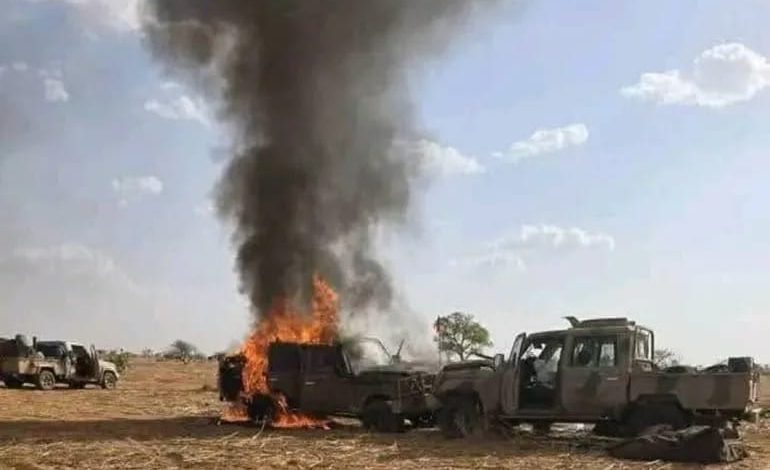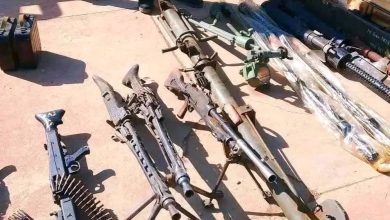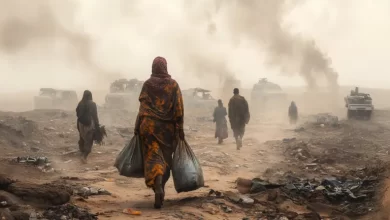Will “Bone-Breaking” Battles in Western Sudan Reshape the Military Map?

Sudan Events – Agencies
The scope of military confrontations between the Sudanese army and the Rapid Support Forces (RSF) has expanded across the three states of the Kordofan region. Experts believe the RSF leadership is attempting to block the army’s advance toward Darfur to prevent it from defending its cities in the region. Observers suggest that battles in West Kordofan could shift the balance of power and reshape the military map in western Sudan.
After the army’s victories in central Sudan—particularly in Sennar, Al-Jazirah, and Khartoum States—it began advancing toward the Darfur region via the three Kordofan states (North, South, and West Kordofan) to secure Khartoum and the country’s center and remove them from the danger zone.
The army successfully expanded into the southern part of North Kordofan State, regaining control of the towns of Umm Rawaba and Al-Rahad and lifting the siege on El-Obeid, the state capital. However, northern localities such as Bara, West Bara, Al-Hamra, and Sodari remain under RSF control.
Map of Control
The army and RSF share control over parts of West Kordofan bordering Darfur. RSF controls areas like Al-Fulah, Al-Mujlad, Abu Zabad, Al-Sunut, Ghbeish, Wad Banda, Al-Iddiyah, Kelek, and Lagawa.
On the other hand, the army controls towns like Babanusa, home to the 22nd Infantry Division command, as well as Al-Khuwai and the oil-rich Heglig.
In South Kordofan, the army holds most major towns, including Kadugli (the state capital), Dilling, Abu Jubeiha, Al-Abbasiya, Tagali, and Kalogi. On Thursday, it also reclaimed the town of Al-Dahileeb from the Sudan People’s Liberation Movement-North (SPLM-N) led by Abdelaziz al-Hilu, located east of Kauda, the movement’s stronghold.
The SPLM-N has controlled the southwestern part of South Kordofan for over three decades, including the localities of Al-Buram, Um Doreen, and Heiban, where it has established civil administrations in Kauda.
Meanwhile, the RSF is present in northern South Kordofan, particularly in Al-Qoz locality, which is witnessing fierce battles following the army’s recent advances.
On Wednesday, the army recaptured Al-Hamadi, which had been under RSF control since the war began, and is approaching Al-Dibibat, the last RSF stronghold in the state.
“Bone-Breaking” Battles
Military sources told Al Jazeera that the RSF perceives a serious threat from the army’s elite “Sayed Operation Force,” which includes highly trained personnel, joint Darfur forces, and support battalions equipped with advanced weaponry and logistics capable of reaching Darfur.
Two weeks ago, the RSF sent large reinforcements to An-Nuhud, the temporary capital of West Kordofan, where senior commanders like Huzayfa Abu Nuba (RSF Advisory Council Head) and spokesman Fateh Qureshi were stationed, according to military sources.
In early May, the RSF captured An-Nuhud, a strategic town connecting Kordofan and Darfur, home to major peanut and gum arabic markets and one of the largest livestock markets in western Sudan.
The RSF also advanced into Al-Khuwai, west of An-Nuhud, on its way toward El-Obeid, but the army retook the town, inflicting heavy losses on the RSF. Military sources described the defeat as comparable to the RSF’s setback in Jabal Moya, Sennar, in October 2023—a turning point that paved the way for liberating Sennar and Al-Jazirah States.
Darfur regional governor Minni Arko Minnawi described the events in Al-Khuwai and surrounding areas as a “bone-breaking battle” in a Facebook post, stating that the road from Kordofan to El-Fasher is now open.
For its part, the RSF claimed to have inflicted heavy casualties on the army and its allies, killing hundreds and seizing dozens of vehicles, declaring its intention to continue advancing in Kordofan and Darfur.
Balance of Power
Military expert Brig. Gen. Omar Bashri told Al Jazeera that in an effort to secure An-Nuhud and reclaim Al-Khuwai, the RSF redeployed large numbers of fighters previously stationed around El-Fasher, East Darfur’s Ed Daein, and the North Desert axis (including Al-Raheb and Al-Atroun via Hamrat Al-Sheikh).
He said the RSF aimed to establish a defensive line extending westward from Al-Khuwai and An-Nuhud through areas like Barush, Jabal Hilla, and Umm Kadada, reaching Koma east of El-Fasher.
Bashri believes the RSF’s recent heavy defeat will pave the way for the army to advance, retake An-Nuhud, and move toward El-Fasher, especially as the RSF has become stretched thin across multiple fronts. The army’s southern advance, including the liberation of Al-Hamadi and nearing Al-Dibibat in South Kordofan, adds to the pressure.
Researcher and military expert Abu Bakr Abdel Rahim sees the West Kordofan battles as a key for the army to penetrate Darfur and secure El-Obeid, the capital of North Kordofan. For the RSF, holding positions in Kordofan and Darfur—and advancing toward El-Obeid—is vital.
Abdel Rahim told Al Jazeera that West Kordofan serves as a strategic control point over the movement routes between El-Obeid and El-Fasher, and between Darfur and North Kordofan, which borders Khartoum State.
Whoever controls West Kordofan effectively controls supply routes and access corridors to Darfur, North Kordofan, and even southern Libya. Politically, controlling Al-Khuwai and An-Nuhud could significantly shift the balance of power.



